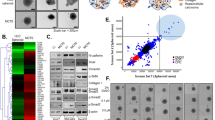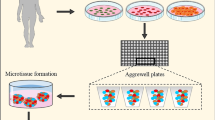Abstract
Liver fibrosis is the late consequence of chronic liver inflammation which could eventually lead to cirrhosis, and liver failure. Among various etiological factors, activated hepatic stellate cells (aHSCs) are the major players in liver fibrosis. To date, various in vitro liver fibrosis models have been introduced to address biological and medical questions. Availability of traditional in vitro models could not fully recapitulate complicated pathology of liver fibrosis. The purpose of this study was to develop a simple and robust model to investigate the role of aHSCs on the progression of epithelial to mesenchymal transition (EMT) in hepatocytes during liver fibrogenesis. Therefore, we applied a micropatterning approach to generate 3D co-culture microtissues consisted of HepaRG and human umbilical cord endothelial cells (HUVEC) which co-cultured with inactivated LX-2 cells or activated LX-2 cells, respectively, as normal or fibrotic liver models in vitro. The result indicated that the activated LX-2 cells could induce EMT in HepaRG cells through activation of TGF-β/SMAD signaling pathway. Besides, in the fibrotic microtissue, physiologic function of HepaRG cells attenuated compared to the control group, e.g., metabolic activity and albumin secretion. Moreover, our results showed that after treatment with Galunisertib, the fibrogenic properties decreased, in the term of gene and protein expression. In conclusion, it is proposed that aHSCs could lead to EMT in hepatocytes during liver fibrogenesis. Furthermore, the scalable micropatterning approach could provide enough required liver microtissues to prosper our understanding of the mechanisms involved in the progression of liver fibrosis as well as high throughput (HT) drug screening.






Similar content being viewed by others
References
Aspera-Werz RH, Chen T, Ehnert S et al (2019) Cigarette smoke induces the risk of metabolic bone diseases: Transforming growth factor beta signaling impairment via dysfunctional primary cilia affects migration, proliferation, and differentiation of human mesenchymal stem cells. Int J Mol Sci. https://doi.org/10.3390/ijms20122915
Azizgolshani H, Coppeta JR, Vedula EM et al (2021) High-throughput organ-on-chip platform with integrated programmable fluid flow and real-time sensing for complex tissue models in drug development workflows. Lab Chip 21:1454–1474. https://doi.org/10.1039/d1lc00067e
Bao YL, Wang L, Pan HT et al (2021) Animal and organoid models of liver fibrosis. Front Physiol. https://doi.org/10.3389/fphys.2021.666138
Barchuk M, Schreier L, Berg G, Miksztowicz V (2020) Metalloproteinases in non-alcoholic fatty liver disease and their behavior in liver fibrosis. Horm Mol Biol Clin Investig 41:1–7. https://doi.org/10.1515/hmbci-2018-0037
Chen W, Yang A, Jia J et al (2020) Lysyl oxidase (LOX) family members: rationale and their potential as therapeutic targets for liver fibrosis. Hepatology 72:729–741. https://doi.org/10.1002/hep.31236
Coll M, Perea L, Boon R et al (2018) Generation of hepatic stellate cells from human pluripotent stem cells enables in vitro modeling of liver fibrosis. Cell Stem Cell 23:101-113.e7. https://doi.org/10.1016/j.stem.2018.05.027
Dewidar B, Meyer C, Dooley S, Meindl-Beinker AN (2019) TGF-β in Hepatic stellate cell activation and liver fibrogenesis-updated 2019. Cells 8:1–35. https://doi.org/10.3390/cells8111419
Dituri F, Cossu C, Mancarella S, Giannelli G (2019) The interactivity between TGFβ and BMP signaling in organogenesis, fibrosis, and cancer. Cells 8:1–21. https://doi.org/10.3390/cells8101130
Dong X, Liu J, Xu Y, Cao H (2019) Role of macrophages in experimental liver injury and repair in mice (Review). Exp Ther Med. https://doi.org/10.3892/etm.2019.7450
Esteves F, Rueff J, Kranendonk M (2021) The central role of cytochrome P450 in xenobiotic metabolism—a brief review on a fascinating enzyme family. J Xenobiotics 11:94–114. https://doi.org/10.3390/jox11030007
Fabregat I, Caballero-Díaz D (2018) Transforming growth factor-β-induced cell plasticity in liver fibrosis and hepatocarcinogenesis. Front Oncol. https://doi.org/10.3389/fonc.2018.00357
Geervliet E, Bansal R (2020) Matrix metalloproteinases as potential biomarkers and therapeutic targets in liver diseases. Cells. https://doi.org/10.3390/cells9051212
Ghezelayagh Z, Zabihi M, Zarkesh I et al (2021) Improved differentiation of hESC-derived pancreatic progenitors by using human fetal pancreatic mesenchymal cells in a micro-scalable three-dimensional co-culture system. Stem Cell Rep. https://doi.org/10.1007/s12015-021-10266-z
Godel M, Morena D, Ananthanarayanan P et al (2020) Small nucleolar RNAs determine resistance to doxorubicin in human osteosarcoma. Int J Mol Sci 21:1–19. https://doi.org/10.3390/ijms21124500
Gröger M, Rennert K, Giszas B et al (2016) Monocyte-induced recovery of inflammation-associated hepatocellular dysfunction in a biochip-based human liver model. Sci Rep 6:1–17. https://doi.org/10.1038/srep21868
Hammad S, Cavalcanti E, Werle J et al (2018) Galunisertib modifies the liver fibrotic composition in the Abcb4Ko mouse model. Arch Toxicol 92:2297–2309. https://doi.org/10.1007/s00204-018-2231-y
Harrison SP, Baumgarten SF, Verma R et al (2021) Liver organoids: recent developments, limitations and potential. Front Med 8:1–18. https://doi.org/10.3389/fmed.2021.574047
Her Z, Tan JHL, Lim YS et al (2020) CD4+ T cells mediate the development of liver fibrosis in high fat diet-induced NAFLD in humanized mice. Front Immunol 11:1–15. https://doi.org/10.3389/fimmu.2020.580968
Hofer M, Lutolf MP (2021) Engineering organoids moritz. Nat Rev Mater 6:402–420. https://doi.org/10.1038/s41578-021-00279-y
Hoffmann SA, Müller-Vieira U, Biemel K et al (2012) Analysis of drug metabolism activities in a miniaturized liver cell bioreactor for use in pharmacological studies. Biotechnol Bioeng 109:3172–3181. https://doi.org/10.1002/bit.24573
Hoffmann C, Djerir NEH, Danckaert A et al (2020) Hepatic stellate cell hypertrophy is associated with metabolic liver fibrosis. Sci Rep 10:1–13. https://doi.org/10.1038/s41598-020-60615-0
Hong Y, Li S, Wang J, Li Y (2018) In vitro inhibition of hepatic stellate cell activation by the autophagy-related lipid droplet protein ATG2A. Sci Rep 8:1–10. https://doi.org/10.1038/s41598-018-27686-6
Jang M, Kleber A, Ruckelshausen T et al (2019) Differentiation of the human liver progenitor cell line (HepaRG) on a microfluidic-based biochip. J Tissue Eng Regen Med 13:482–494. https://doi.org/10.1002/term.2802
Kanuri G, Bergheim I (2021) In vitro and in vivo models of non-alcoholic fatty liver disease: a critical appraisal. J Clin Med 10:11963–11980. https://doi.org/10.3390/jcm10010036
Khanam A, Saleeb PG, Kottilil S (2021) Pathophysiology and treatment options for hepatic fibrosis: can it be completely cured? Cells. https://doi.org/10.3390/cells10051097
Kim J, Koo BK, Knoblich JA (2020) Human organoids: model systems for human biology and medicine. Nat Rev Mol Cell Biol 21:571–584. https://doi.org/10.1038/s41580-020-0259-3
Kitto LJ, Henderson NC (2021) Hepatic stellate cell regulation of liver regeneration and repair. Hepatol Commun 5:358–370. https://doi.org/10.1002/hep4.1628
Kostrzewski T, Snow S, Battle AL et al (2021) Modelling human liver fibrosis in the context of non-alcoholic steatohepatitis using a microphysiological system. Commun Biol. https://doi.org/10.1038/s42003-021-02616-x
Kunst RF, Niemeijer M, van der Laan LJW et al (2020) From fatty hepatocytes to impaired bile flow: Matching model systems for liver biology and disease. Biochem Pharmacol 180:114173. https://doi.org/10.1016/j.bcp.2020.114173
Luangmonkong T, Suriguga S, Bigaeva E et al (2017) Evaluating the antifibrotic potency of galunisertib in a human ex vivo model of liver fibrosis. Br J Pharmacol 174:3107–3117. https://doi.org/10.1111/bph.13945
Müller FA, Sturla SJ (2019) Human in vitro models of nonalcoholic fatty liver disease. Curr Opin Toxicol 16:9–16. https://doi.org/10.1016/j.cotox.2019.03.001
Paish HL, Reed LH, Brown H et al (2020) A bioreactor technology for modeling fibrosis in human and rodent precision-cut liver slices. Hepatology 70:1377–1391. https://doi.org/10.1002/hep.30651
Retting K, Carter D, Crogan-Grundy C et al (2018) Modeling liver biology and the tissue response to injury in bioprinted human liver tissues. Appl Vitr Toxicol 4:288–303. https://doi.org/10.1089/aivt.2018.0015
Roehlen N, Crouchet E, Baumen TE (2020) Liver fibrosis: mechanistic concepts and Therapeutic Perspectives. Cells 3;9(4):1–43
Ruoß M, Häussling V, Schügner F et al (2018) A standardized collagen-based scaffold improves human hepatocyte shipment and allows metabolic studies over 10 days. Bioengineering. https://doi.org/10.3390/bioengineering5040086
Ruoß M, Damm G, Vosough M et al (2019) Epigenetic modifications of the liver tumor cell line HepG2 increase their drug metabolic capacity. Int J Mol Sci. https://doi.org/10.3390/ijms20020347
Ruoß M, Kieber V, Rebholz S et al (2020a) Cell-type-specific quantification of a scaffold-based 3d liver co-culture. Methods Protoc 3:1–19. https://doi.org/10.3390/mps3010001
Ruoß M, Rebholz S, Weimer M et al (2020b) Development of scaffolds with adjusted stiffness for mimicking disease-related alterations of liver rigidity. J Funct Biomater 11:1–19. https://doi.org/10.3390/jfb11010017
Sacchi M, Bansal R, Rouwkema J (2020) Bioengineered 3D models to recapitulate tissue fibrosis. Trends Biotechnol. https://doi.org/10.1016/j.tibtech.2019.12.010
Sanz-García C, Fernández-Iglesias A, Gracia-Sancho J et al (2021) The space of disse: the liver hub in health and disease. Livers 1:3–26. https://doi.org/10.3390/livers1010002
Serras AS, Rodrigues JS, Cipriano M et al (2021) A critical perspective on 3D liver models for drug metabolism and toxicology studies. Front Cell Dev Biol 9:1–30. https://doi.org/10.3389/fcell.2021.626805
Song Y, Kim S, Heo J et al (2021) Identification of hepatic fibrosis inhibitors through morphometry analysis of a hepatic multicellular spheroids model. Sci Rep 11:1–12. https://doi.org/10.1038/s41598-021-90263-x
Van Norman GA (2019) Limitations of animal studies for predicting toxicity in clinical trials: is it time to rethink our current approach? JACC Basic to Transl Sci 4:845–854. https://doi.org/10.1016/j.jacbts.2019.10.008
Vijayaraj P, Minasyan A, Durra A et al (2019) Modeling progressive fibrosis with pluripotent stem cells identifies an anti-fibrotic small molecule. Cell Rep 29:3488-3505.e9. https://doi.org/10.1016/j.celrep.2019.11.019
Wang G, Zheng Y, Wang Y et al (2018) Co-culture system of hepatocytes and endothelial cells: two in vitro approaches for enhancing liver-specific functions of hepatocytes. Cytotechnology 70:1279–1290. https://doi.org/10.1007/s10616-018-0219-3
Wen Y, Lambrecht J, Ju C, Tacke F (2021) Hepatic macrophages in liver homeostasis and diseases-diversity, plasticity and therapeutic opportunities. Cell Mol Immunol 18:45–56. https://doi.org/10.1038/s41423-020-00558-8
Weng W, Zanetti F, Bovard D et al (2021) A simple method for decellularizing a cell-derived matrix for bone cell cultivation and differentiation. J Mater Sci Mater Med. https://doi.org/10.1007/s10856-021-06601-y
Wu Y, Cao Y, Xu K et al (2021) Dynamically remodeled hepatic extracellular matrix predicts prognosis of early-stage cirrhosis. Cell Death Dis. https://doi.org/10.1038/s41419-021-03443-y
Wuensch T, Heucke N, Wizenty J et al (2019) Hepatic CYP1A2 activity in liver tumors and the implications for preoperative volume-function analysis. Am J Physiol Gastrointest Liver Physiol 316:G608–G614. https://doi.org/10.1152/ajpgi.00335.2018
Zahmatkesh E, Ghanian MH, Zarkesh I et al (2021a) Tissue-specific microparticles improve organoid microenvironment for efficient maturation of pluripotent stem-cell-derived hepatocytes. Cells 10:(6):1–23
Zahmatkesh E, Khoshdel-Rad N, Mirzaei H et al (2021b) Evolution of organoid technology: Lessons learnt in Co-Culture systems from developmental biology. Dev Biol 475:37–53. https://doi.org/10.1016/j.ydbio.2021.03.001
Zhou J, Cui S, He Q et al (2020) SUMOylation inhibitors synergize with FXR agonists in combating liver fibrosis. Nat Commun 11:1–16. https://doi.org/10.1038/s41467-019-14138-6
Zhu S, Aspera-Werz RH, Chen T et al (2021) Maqui berry extract prevents cigarette smoke induced oxidative stress in human osteoblasts in vitro. EXCLI J 20:281–296. https://doi.org/10.17179/excli2020-3244
Funding
This project was financially supported by grants from “The National Institute for Medical Research Development (NIMAD, 940231 and 982403), Tehran, Iran”, to M.V. In addition, the project was partially funded by institutional funding and a grant by the Federal Ministry of Education and Research (FZK: 01DK20020) to AN.
Author information
Authors and Affiliations
Contributions
EZ performed all the experiments and drafted the manuscript. EZ, MV, AN, MR, AO, RA, BB were involved in the bioassays and analysis and discussion of data. AP revised and approved the manuscript critically. MV & AN developed the idea, supported the project, and revised and finally approved the manuscript.
Corresponding author
Ethics declarations
Conflict of interest
The authors declare no conflict of interest.
Additional information
Publisher's Note
Springer Nature remains neutral with regard to jurisdictional claims in published maps and institutional affiliations.
Supplementary Information
Below is the link to the electronic supplementary material.
Rights and permissions
About this article
Cite this article
Zahmatkesh, E., Othman, A., Braun, B. et al. In vitro modeling of liver fibrosis in 3D microtissues using scalable micropatterning system. Arch Toxicol 96, 1799–1813 (2022). https://doi.org/10.1007/s00204-022-03265-7
Received:
Accepted:
Published:
Issue Date:
DOI: https://doi.org/10.1007/s00204-022-03265-7




